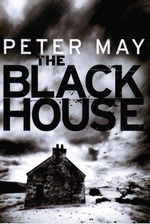 The Blackhouse
The Blackhouse
by Peter May
Series: The Lewis Trilogy, #1
Hardcover, 357 pg.
SilverOak Books, 2012
Read: December 18 – 19, 2017

Endinburgh’s DS Fin Macleod returns to work after a month’s bereavement leave and is immediately sent to the Isle of Lewis to aid in a murder investigation. The murder shares some commonalities with a murder he’d been investigating before his leave and Fin grew up in the same town as the murder — in fact, he knew the victim as a child and was bullied by him. Fin has returned to the island once since he left, and that was almost two decades ago — nevertheless he is surrounded by memories and ghosts.
As is so often the case with this kind of story — the returning detective/writer/lawyer/etc. — the narrative is divided between the present and the past. In the present we get Fin and his local contact looking into aspects of the murder, drawing on Fin’s knowledge of the suspects and other persons of interest. The other portion traces Fin’s friendships and lost loves on the island, his problematic relationship to the island’s culture, and some of the trauma of his life. In the end, as every reader knows, the past illuminates the present and Fin’s able to solve the mystery — at great cost to himself.
May structured this wonderfully, the prose is gripping, the characters well-developed and believable — you can feel the harsh environment, the cold, the isolation.
But . . . I just didn’t like it. I can’t point to anything in particular that put me off, I just didn’t click with it. I didn’t dislike it either, I should say.
Strong writing, a great sense of setting, a story well told — I can see why so many readers appreciated it, and figure many of my readers will, too. But it just didn’t do enough for me. I’ll give it 3 1/2 stars on the strength of May’s skill alone.
—–



